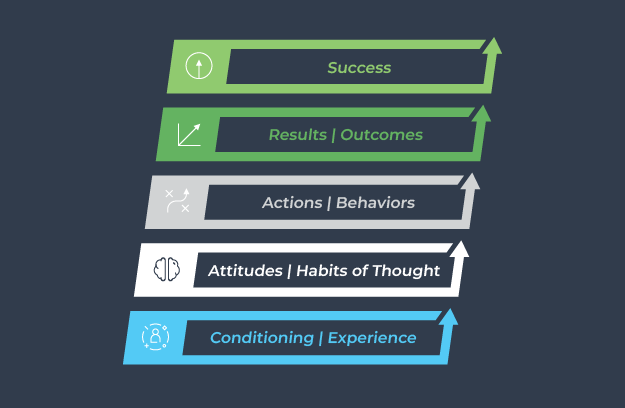Goals start with a spark, an ambition, an intention. At first, you’re fired up. Then, as the weeks go on, your ambition drains. What was once the most important thing is now in the back seat. Before you know it, your motivation has now wandered to the new shiny object in the room. Not because the previous goal is less important than the new one, but because you are human.
Studies show that dopamine is released every time you set a new goal. Just from the anticipation of achieving it. All humans experience this, we are hard wired for the shiny object. We set goal after goal because it feels good.
You’re not alone. And the problem isn’t your ambition, it’s your system. When you rely on ambition alone, ambition drains. Enter the Success Chain™. The Success Chain™ is something that the world’s highest performers use every day (they just might not know it).

What is the Success ChainTM
The Success Chain™ is a simple, yet comprehensive framework that maps your path to success. It connects what you want to how you get there. It’s about taking the initial spark of ambition and creating consistent habits to fan the flame and create real results. Here’s the breakdown:
Let’s start at the bottom and move up.
- Conditioning and Experience
- Attitudes and Habits of Thought
- Actions and Behaviors
- Results and Outcomes
- Success
The powerful thing about the Success Chain™ is that it’s all connected.
Your past experiences shape how you think.
Your thoughts drive your behaviors.
Your behaviors produce your results.
And your results create the feeling of success.
And the feeling of success reinforces your beliefs and experiences—completing the loop!
How it looks to set a goal with the Success Chain™
1. Define Success
Vague goals = vague results.
Instead of “I want to be a better leader,” say: “I’ll increase team engagement and retention by XX%.”
Leadership goals are often hard to measure by themselves, which is why it’s essential to tie measurable behaviors to them. If your goal isn’t measurable, it’s not actionable. Define success in a way that you can track.
Remember when I said, “setting goals releases dopamine”? Making measurable progress toward your goals does the same thing. Making goals you can clearly measure allows you to rekindle the ambition you felt when you first set the goal.
Interested in learning more about setting realistic goals? Watch this Coffee with Kathy episode.
2. Pinpoint Desired Outcomes and Results
Success is the feeling.
But what are the tangible results and outcomes you want to achieve? What will actually make you feel like you’re increasing team engagement and retention?
Is it improved communication? Better team camaraderie? More innovation?
Ask yourself, what does progress look like? What changes will make you proud?
3. Start with what you can control
Big wins are built on small, consistent, repeatable actions. Once you know your destination, work backwards. Map out the steps you can take today, tomorrow and so on. Long-term action planning on a goal is great, but goals are meant to be agile. Actively measure the impact of actions and behaviors and be prepared to adjust based on results!
If your goal is to boost employee engagement, new habits might include:
- Giving daily positive feedback
- Holding weekly brainstorming sessions
- Asking team members for input before making major decisions
- Holding one-on-ones with direct reports
- Monthly team lunches
When you make these new habits a part of your daily, weekly, or monthly routine, progress is inevitable. It’s easy to get discouraged or lose sight of a goal when it seems like one giant to-do. So break it into smaller, more digestible steps!
4. Adjust your mindset
Mindset might feel abstract, but it’s one of the most impactful tools you have.
Emotions and feelings can often feel like they are out of your control. We all have those ‘I can’t do this’ moments. What you do with them and how you let them affect your mindset, is completely up to you.
Maybe your calendar’s packed and there’s no room for one-on-ones. Maybe your team seems lukewarm about the changes.
Feel it. Name it. And then remind yourself—growth is messy. “These changes are difficult now, but they’re moving me forward.” “I don’t have all the answers, but I will learn.”
A growth mindset isn’t about toxic positivity. It’s about trusting that today’s discomforts lead to tomorrow’s success.
5. Consider past experiences and conditioning
Now consider something you can’t control. Your past.
You can’t change it, but you can learn from it.
Our behaviors and mindsets are shaped by past experiences and conditioning. Do you find it difficult to give feedback to your direct reports? Perhaps at your last company, your boss thought that “giving feedback” meant ripping apart your work with little to no tact.
That experience can shape how you approach giving feedback now that you’re in a leadership role. Recognize where your thoughts and habits may be coming from and take time to understand whether those thoughts are benefiting or hindering your journey to success.
Time to Take Action
Now it’s your turn. Pick a goal, apply the Success Chain™, and take the first step today. Remember: small, consistent, and repeatable actions create massive results.
So—what’s your next move?
Interested in building new habits, but don’t know where to start? Check out our blog…






